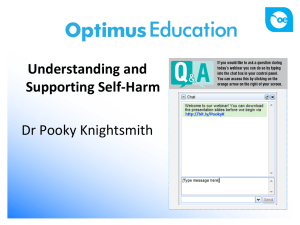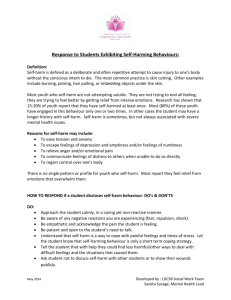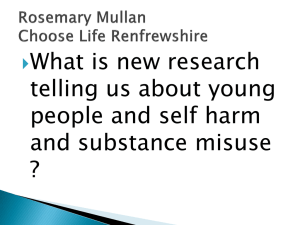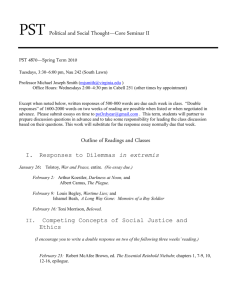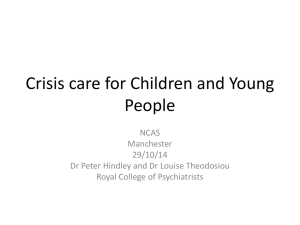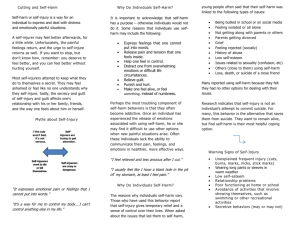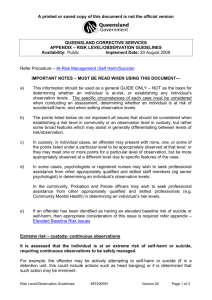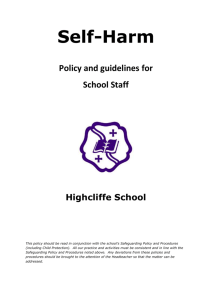Problem-solving therapy (PST)
advertisement
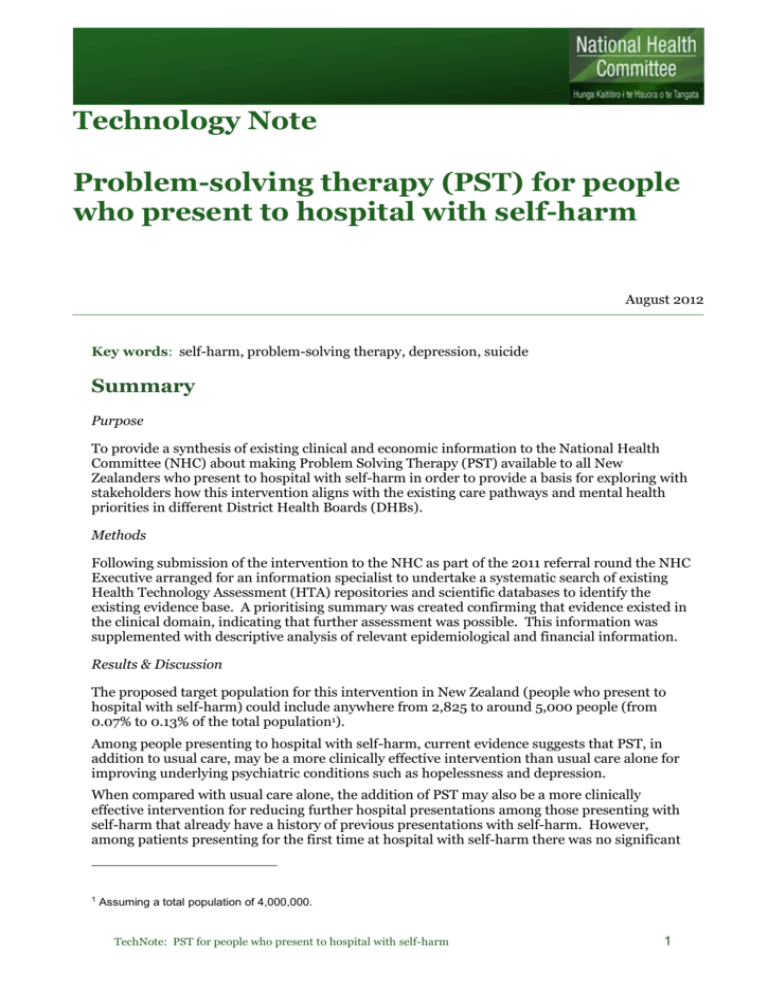
Technology Note Problem-solving therapy (PST) for people who present to hospital with self-harm August 2012 Key words: self-harm, problem-solving therapy, depression, suicide Summary Purpose To provide a synthesis of existing clinical and economic information to the National Health Committee (NHC) about making Problem Solving Therapy (PST) available to all New Zealanders who present to hospital with self-harm in order to provide a basis for exploring with stakeholders how this intervention aligns with the existing care pathways and mental health priorities in different District Health Boards (DHBs). Methods Following submission of the intervention to the NHC as part of the 2011 referral round the NHC Executive arranged for an information specialist to undertake a systematic search of existing Health Technology Assessment (HTA) repositories and scientific databases to identify the existing evidence base. A prioritising summary was created confirming that evidence existed in the clinical domain, indicating that further assessment was possible. This information was supplemented with descriptive analysis of relevant epidemiological and financial information. Results & Discussion The proposed target population for this intervention in New Zealand (people who present to hospital with self-harm) could include anywhere from 2,825 to around 5,000 people (from 0.07% to 0.13% of the total population1). Among people presenting to hospital with self-harm, current evidence suggests that PST, in addition to usual care, may be a more clinically effective intervention than usual care alone for improving underlying psychiatric conditions such as hopelessness and depression. When compared with usual care alone, the addition of PST may also be a more clinically effective intervention for reducing further hospital presentations among those presenting with self-harm that already have a history of previous presentations with self-harm. However, among patients presenting for the first time at hospital with self-harm there was no significant 1 Assuming a total population of 4,000,000. TechNote: PST for people who present to hospital with self-harm 1 difference in the primary outcome (re-presentation with self-harm) when compared with usual care alone. There is currently no information on the cost-effectiveness of PST plus usual care. While a trial is currently underway that includes PST as part of a package of care, the individual contribution to the results from PST in isolation from the other interventions may not be possible to determine. If the PST plus usual care remains the intervention of interest, further work is required to assess the cost-effectiveness of the intervention. Conclusion: The decision around whether or not to make PST available to all New Zealanders that present to hospital with self-harm depends on the outcome the Committee seeks to influence. If the main intent is to improve the underlying psychiatric conditions of these patients, then current evidence suggests PST & usual care is more clinically effective than only usual care. However, if the main intent is to reduce presentations to hospital with self-harm then the addition of PST to usual care is not clinically effective in all patients presenting with self-harm – rather it is only so in those for whom it is their second or subsequent presentation. Furthermore, if the main intent is to prevent deaths by suicide, there is currently no evidence that the provision of PST to people presenting with self-harm will achieve this. The outcome decision-makers seek to influence will determine how this intervention should be prioritised relative to other interventions seeking to improve mental health in different population groups. Purpose The purpose of this technology note is to provide information to the National Health Committee (NHC) about making PST available to all New Zealanders who present to hospital with selfharm. This information will be used by the Committee to: Understand how this intervention compares with the current treatment protocol for patients that present to hospital with self-harm in terms of safety, clinical effectiveness and cost-effectiveness. Determine what further information is required in order to recommend whether or not the intervention should be provided to all New Zealanders who present to hospital with self-harm. Start engaging with the sector around whether all costs and benefits have been accurately captured and the priority and feasibility of introducing the intervention in New Zealand relative to other interventions that might be available for addressing the health outcomes of interest. Context & policy issues In 2011 the NHC received a referral proposing that PST should be available to all New Zealanders who present to hospital with self-harm. The NHC chose to add this intervention to their work programme for further assessment because it looked like it could be a clinically and cost-effective way of reducing self-harm and suicide rates in New Zealand, particularly among youth (15 – 24 year-olds),which are relatively high compared with other OECD countries. They also identified that as the rate of self-harm and suicide is higher among some ethnic and socioeconomic groups than others, this intervention had the potential to reduce disparities in health outcomes. Methodology A list of key words was sent to the Ministry of Health’s information specialist to be used to identify existing HTA reports, systematic reviews, and randomised controlled trials (RCTs) that TechNote: PST for people who present to hospital with self-harm 2 might be related to the intervention. The search was run between 23 November 2011 and 13 December 2011 in Ovid MEDLINE(R) and Cochrane Library databases using the following search criteria: problem solving therapy, suicide, RCTs and systematic reviews; Limits: Clinical trial, phase iii or clinical trial, phase iv or guideline or meta-analysis or randomized controlled trial or systematic review. No date parameters were used but the search was restricted to papers published in the English language. To supplement this information, and obtain information on epidemiological burden, the internet was also used, and in particular the data & statistics pages and mental health and addictions pages of the Ministry of Health website. Information contained in the referral and the feedback received from the sector on the referral was also considered. Nature of the health problem or disease Self-harm is defined as intentional self-poisoning or self-injury, irrespective of motivation. Selfpoisoning includes the intentional ingestion of more than the prescribed amount of any drug, whether or not there is evidence that the act was intended to result in death. This also includes poisoning with non-ingestible substances (for example pesticides or carpet cleaner), over doses of ‘recreational drugs’ and severe alcohol intoxication where clinical staff considers such cases to be an act of intentional self-harm (Hatcher et al 2011a). Epidemiology & burden of disease In 2010 there were 2,825 hospitalisations for intentional self-harm (66.0 per 100,000)2 and 522 deaths from suicide (11.5 per 100,000) in New Zealand (Ministry of Health 2012). Females continue to have significantly higher rates of self-harm than males (Figure 1), but males continue to have higher suicide rates (Ministry of Health 2012). Figure 1: Intentional self-harm hospitalisation age-standardised rates, by sex, 1996–2010 Rate 120 Males Females 100 80 60 40 20 0 1996 1997 1998 1999 2000 2001 2002 2003 2004 2005 2006 2007 2008 2009 2010 Year 2 It is important to note that hospitalisations for intentional self-harm represent individual events of self-harm rather than individual people: a single person can contribute numerous unique intentional self-harm events to the data set. TechNote: PST for people who present to hospital with self-harm 3 Source: New Zealand National Minimum Dataset (Ministry of Health 2012) Note: The rate shown is the age-standardised rate per 100,000 population, standardised to the WHO standard world population. Suicide and self-harm rates are significantly higher in the most deprived areas than in the least deprived areas and Maori have higher rates than non-Maori (Figure 2) (Ministry of Health 2012). While 20 - 24 year olds tend to have the highest rates of suicide in New Zealand, 15 – 19 year olds have the highest rates of self-harm. Hospitalisations for self-harm also vary by DHB (Figure 3). Figure 2: Intentional self-harm hospitalisation age-standardised rates, Māori and non-Māori, 1996– 2010 Rate 100 Māori Non-Māori 90 80 70 60 50 40 30 20 10 0 1996 1997 1998 1999 2000 2001 2002 2003 2004 2005 2006 2007 2008 2009 2010 Year Source: New Zealand National Minimum Dataset (Ministry of Health 2012) Note: The rate shown is the age-standardised rate per 100,000 population, standardised to the WHO standard world population. TechNote: PST for people who present to hospital with self-harm 4 Figure 3: Intentional self-harm hospitalisation age-standardised rates, by DHB of domicile, 2008, 2009 and 2010 (accumulated data) Rate 250 DHB rate National rate 200 150 100 50 Southland Otago South Canterbury Canterbury West Coast Nelson Marlborough District Health Board Wairarapa Hutt Valley Capital & Coast Whanganui MidCentral Taranaki Hawke’s Bay Tairawhiti Bay of Plenty Lakes Waikato Counties Manukau Auckland Waitemata Northland 0 Source: New Zealand National Minimum Dataset (Ministry of Health 2012) Note: The rate shown is the age-standardised rate per 100,000 population, standardised to the WHO standard world population. The hospitalisations for intentional self-harm data recorded in the national minimum dataset do not represent the total number of people receiving hospital treatment for intentional self-harm (Ministry of Health 2012). The excluded data represents patients who were discharged from an emergency department after a length of stay of less than two days as this practice varies among DHBs. The data presented here also excludes any admissions for an intentional self-harm incident within two days of a previous discharge involving intentional self-harm as sometimes these are transfers between hospitals. However, even once consistency issues between DHBs are addressed, the total extent of intentional self-harm is still difficult to capture, because many people who intentionally selfharm do not seek hospital treatment. The size of the target group for the proposed intervention is therefore difficult to determine, but could include anywhere from 2,825 individuals to around 50003 (assuming 28.1% (Gibb et al 2005) of all self-harm presentations are repeat presentations). Compared with other OECD countries, rates of suicide in New Zealand are relatively high. Similar comparisons for self-harm hospitalisations were unavailable (Figure 4.) 3 Adding the number of short-stay ED hospitalisations in 2010 (3665) that are excluded from analyses of the national collections increases the total number of cases to 6490. Assuming 28.1% of these are readmissions, the total could be 5000. TechNote: PST for people who present to hospital with self-harm 5 Figure 4: Suicide age-specific rates for OECD countries, males & females, 15–24 years Country Estonia 2008 Finland 2009 Ireland 2009 New Zealand 2010 Chile 2007 Japan 2009 Poland 2008 Hungary 2009 Canada 2004 Switzerland 2007 USA 2005 Norway 2009 Republic of Korea 2009 Sweden 2008 Belgium 2005 Slovenia 2009 Austria 2009 Slovakia 2005 Australia 2006 Czech Republic 2009 Mexico 2008 France 2007 Germany 2006 United Kingdom 2009 Israel 2007 Denmark 2006 Netherlands 2009 Portugal 2009 Italy 2007 Spain 2008 Greece 2009 a. 0 5 10 15 Rate 20 25 30 b. Source: WHO (nd) (Ministry of Health 2012) Note: a. Males b. Females. The rate in these figurse is the age-specific rate, measuring the frequency of suicides per 100,000 population. Treatments for self-harm and current practice The current treatment protocol (ie, usual care) for people presenting to hospital with self-harm varies (Hatcher et al 2011b). Usual care may involve referral to multidisciplinary teams for psychiatric or psychological intervention, referral to mental health crisis teams, recommendations for engagement with alcohol and drug treatment centres or other health and non-health services. Technology Status The intervention being proposed consists of between four and nine hour long sessions of PST, which start as soon as practicable after the index self-harm episode and lasts for up to 3 months. It is proposed that the therapy is conducted with individual patients in out-patient clinics according to the model originally defined by D’Zurilla & Goldfried (1971). The steps include problem orientation, problem listing and definition, brainstorming, devising an action plan and reviewing the plan. Problem orientation is a person’s approach to problems which varies from ignoring them and hoping they will go away (negative orientation) to seeing them as opportunities and challenges to do things differently (positive orientation). Requirements for use PST can be used in a variety of follow-up settings as part of the treatment plan including in primary, community and secondary care. It is usually provided face-to-face in a quiet, private space which could be an office, a private room, or someone’s home. It is proposed that PST would be delivered by therapists trained in PST and could be delivered through existing mental health crisis teams or liaison psychiatry services. Anyone can be trained in PST (they do not need a background in mental health), but the usual candidates would be individuals with backgrounds in social work, psychotherapy, counselling, health psychology, nursing, and education. Depending on the current level of skill and experience, PST training might take TechNote: PST for people who present to hospital with self-harm 6 anywhere between one day to one week. supervision. Therapists delivering PST would also require Current status in New Zealand and overseas It is unclear to what extent PST is being used regularly in conjunction with usual care internationally or in New Zealand. However, in New Zealand the intervention has been available under trial conditions since September 2005 in North Shore Hospital, Waitakere Hospital (Waitemata DHB); Middlemore Hospital (Counties Manukau DHB); Whangarei Hospital (Northland DHB); Wellington Hospital and Kenepuru Hospitals (Capital and Coast DHB), which account for a third of the total New Zealand population (Hatcher et al 2011b). Clinical safety & effectiveness Information compiled in this section of the paper seeks to address the question of whether not the provision of PST plus usual care is a more clinically safe and effective treatment for people who present to hospital with self-harm than usual care alone. The primary outcome measure of effectiveness is subsequent presentation to hospital with self-harm in the year after the initial presentation. The secondary outcomes include the impact of the intervention on hopelessness, depression, suicidal ideas and problem solving. Three relevant papers were identified by the NHC Executive and summarised below. Overall, current evidence suggests that PST is not a more clinically safe or effective intervention for reducing hospital presentations for self-harm compared with usual care. However, there is some evidence suggesting that PST plus usual care may be more effective than usual care alone for patients with previous hospital presentations with self-harm. There is also some evidence suggesting that PST, in addition to usual care, may reduce hopelessness, suicidal thinking, anxiety, and depression and increase problem solving ability. The impact of the intervention on deaths by suicide is unclear. Safety No adverse effects from PST have been investigated. Effectiveness All the studies identified examined the effectiveness of the intervention in self-harm patients aged 15 years or over. In 2008 the British Medical Journal (BMJ) Group published the findings of a 2006 review of existing systematic reviews and RCTs investigating both the primary and secondary outcomes described above (Soomro 2008). The single systematic review they identified relevant to the primary outcome concluded that repetition of self-harm 6-12 months following the intervention was not significantly different between those receiving PST and those receiving usual care (Soomro 2008). However, in terms of secondary outcomes such as hopelessness and depression, the review concluded that PST might be more effective than usual care, though noted that the evidence was of low quality. Another systematic review of PST as a treatment for depression was published following the 2006 BMJ review (Gellis and Kenaley 2008). This review found mixed evidence on the effectiveness of PST as a treatment for depression, but that PST combined with antidepressant treatment had more favourable outcomes than PST alone. A New Zealand based RCT conducted between 2005 and 2008 investigated both the primary and secondary outcomes of interest (Hatcher et al 2011b). The trial restricted participation to patients who presented to hospital after self-harm who were not at school and were more than 16 years old; were not receiving dialectical behaviour therapy for borderline personality disorder or had a management plan which precluded having a short-term therapy; were not cognitively impaired; and had not been admitted to a psychiatric unit following the index presentation for longer than 48 hours. TechNote: PST for people who present to hospital with self-harm 7 Participants were randomised to problem- solving therapy plus usual care or usual care alone. In terms of the primary outcome measure, the trial found that overall there was no significant difference between the hospital presentations with self-harm in those randomised to PST plus usual care compared with those randomised to usual care alone. However, for patients whose index episode was a repeat presentation, those who received PST plus usual care were less likely to present again to hospital with self-harm after a year than those receiving only usual care. In terms of the secondary outcomes of interest the study found a dose-response relationship between the amount of problem-solving therapy received and the secondary outcome measures of hopelessness, suicide ideation, anxiety and depression, and increases in problem solving, with more sessions resulting in better scores. Overall the study concluded that PST is not a recommended intervention for everyone that presents to hospital with self-harm, but it may be an effective intervention among adults with a history of self-harm. Outstanding uncertainty It is unclear whether there are any adverse effects from PST, what effect (if any) the intervention has on deaths by suicide, and whether or not the effectiveness of the intervention varies by ethnicity, age, or socio-economic status. Furthermore, patients in the New Zealand trial were only followed up for one year after provision of the intervention so how long these benefits are retained for is unknown. Will patients need supplementary sessions every few years for the benefits to be maintained? Economic (Cost-effectiveness) The objective of this domain is to synthesise the available information relevant to answering the question of whether or not the use of PST (alongside usual care) in people presenting to hospital with self-harm is a more cost-effective treatment than usual care alone for preventing repeat presentations for self-harm and improving psychiatric conditions. At present there are no published studies investigating the cost-effectiveness of PST and usual care compared with usual care alone in patients presenting to hospital with self-harm. The results from a New Zealand trial of a package of measures (which include PST alongside other interventions4) are due in August 2012. However, as this trial examines PST as part of a package of interventions (not just PST plus usual care) (Hatcher et al 2011a), the impact, and therefore cost-effectiveness of only PST alongside usual care may be undeterminable. What are the relevant costs associated with self-harm and the intervention? It is estimated that presentations to hospital with self-harm cost the New Zealand health sector approximately $2,287 per event and $12.7 million in total per annum (Table 1). The total cost of introducing PST is currently unknown, but it is expected to be between $282 and $564 per selfharm presentation (~$434-$868 per patientd.) which equates to between $1.6 and $3.1 million per annum. Table 1: Costs associated with hospital presentations with self-harm and the provision of problem solving therapy Item Medical costs associated with selfharm 4 Cost (NZ$2009/10) Per event Source Per annum These include regular written communication, patient support, cultural assessment, improved access to primary care and a risk management strategy in people who present to hospital after self-harm. TechNote: PST for people who present to hospital with self-harm 8 Presentation to the emergency department with self-harm $2,287a. $12,656,258 Calculation for annual total assumes 5,534 publicly funded admissions (NHC Executive Analysis of NMDS) $282-$564c. $1,560,000$3,120,000 b. Assuming that these 5,534 admissions are accounted for by only 3,596 people (NHC Executive Analysis of NMDS), approximately 24 therapists trained in PST will be required. For each therapist to see 75-150 people per year it costs $65,000 (Referral). This estimate assumes they can see 150. Problem solving therapy (PST) Therapist Therapist training TBC TBC Unknown Therapist supervision TBC TBC Unknown Materials TBC TBC Unknown Presentation to the emergency department with self-harm -$59.60e.. -$329,842 PST is estimated to save money through reducing re-admissions in some patient groups (ie, those with a history of selfharm). Assuming there are 166 fewer presentations and each costs $1,987 (see Table 2). Notes: a. $12,656,258/5,534 b. $65,000*24=$1,560,000 c. $329,842 /5,534 =$59.60 d. $1,560,000/3,596=$434 e. $1,500,000/5,534 What are the benefits associated with the intervention? Assuming that the efficacy of the intervention in trial conditions can be achieved in the real world, the intervention may reduce the number of re-presentations for self-harm (primary outcome) among patients with a history of self-harm from 1,9385 to 1,182 (Table 2). These readmissions have an average case-weighted price of $1,987 (09/10 dollars) and a total price of $3.4 million (09/10 dollars). If readmissions for self-harm can be reduced by 8.6% in this group, admissions would reduce by 166 and the total price by $329,842 per annum. Note that the evidence suggests that the intervention will not affect repeat presentations for self-harm among people presenting to hospital with self-harm for the first time. 5 NHC Executive analysis of NMDS data with a previous admission with an external cause (ICD-10-AM code) of selfharm in the last year (2009-2010). TechNote: PST for people who present to hospital with self-harm 9 Table 2: Possible improvements in primary and secondary outcomes following the provision of PST alongside usual care to patients presenting to hospital with self-harm Outcome measure Primary outcome Reduction in re-presentation to the emergency department with self-harm within 1 year of index presentation for patients with a history of self-harm. Secondary outcomes Effect RR reduction 0.39 Source & Notes Reduction in number Risk difference 8.6%6 166 RR Reduction obtained from Hatcher et al (2011b). Number of presentations calculated on basis that if the number of current repeat admissions in this group (1,938) was reduced by 8.6%, there would be 166 fewer presentations. Mean difference in score (All) Mean difference in score (patients ≥4 PST sessions) NB: Mean difference in score is between PST vs Treatment as usual (TAU) groups. 2.3 2.9 Hatcher (2011b) – refers to a decrease in hopelessness cf with TAU. Improved suicide ideation score 1.6 1.9 Hatcher (2011b) - refers to a decrease in suicide ideation cf with TAU. Improved social problemsolving inventory score -4.2 -5.1 Hatcher (2011b) – refers to an increase in problem solving ability cf TAU. 1.0 1.3 Hatcher (2011b) – refers to a decrease in anxiety cf with TAU. 1.4 1.9 Improved hopelessness score Improved anxiety score Improved depression score Hatcher (2011b) – refers to a decrease in depression cf with TAU. Notes: RR= Relative risk; TAU=Treatment as Usual; Cf=Compared with; NB=Note Conclusion Assuming that the trial results can be extrapolated to the general population, spending about $1.6 - $3.1 million per annum on providing PST to people presenting to hospital with self-harm could prevent 166 re-presentations in the following year, save $329,842, and improve secondary outcomes in this group such as hopelessness and depression. Given that there was no evidence that the intervention significantly altered the primary outcome (repeat presentations) among all people presenting with self-harm, provision of PST may be more cost-effective if it were restricted to the sub-group of the population that there is evidence that this intervention has been shown to benefit. 6 Repetition rate of self-harm in Treatment as usual (TAU)=22.1% and PST=13.5%. Therefore risk difference =8.6% (22.1%-13.5%) TechNote: PST for people who present to hospital with self-harm 10 Recommendations Among those presenting to hospital with self-harm, who do not have a previous history of selfharm, PST combined with usual care is not more effective than usual care alone for preventing future self-harm presentations. However, there is some evidence suggesting that the intervention can improve hopelessness and depression in this group. Whether or not PST should be made available to all New Zealanders who present to hospital with self-harm depends on what decision-makers are hoping to achieve through the intervention. Table 3 below shows how the recommendation varies according to the outcome decision-makers seek to influence. There are a number of questions that still need to be answered, so in all cases further work may be required. Outstanding questions 1. Are there any adverse effects associated with the use of PST? 2. Does the clinical effectiveness of the intervention vary by ethnicity, age, or socio-economic status? 3. What is the size of the actual patient group in New Zealand that there is evidence supporting that this intervention is effective in? For instance, the New Zealand trial excluded patients <16 years of age who were receiving dialectical behaviour therapy for borderline personality disorder or had a management plan which precluded having a short-term therapy; were cognitively impaired; or had been admitted to a psychiatric unit following the index presentation for longer than 48 hours. This strict eligibility criteria excluded 931 (46%) of the 2,025 people presenting to the trial hospitals with self-harm (Hatcher et al 2011b). If 46% of all people presenting to hospital with self-harm in New Zealand are also ineligible due to having any of these characteristics, it would mean that of the 3,596 people7 in New Zealand presenting to hospital with self-harm annually, only 1,6548 would be eligible for PST, and of these, evidence suggests that only 1429 are likely to experience an improvement in the primary outcome. 4. Is this the most clinically-effective and cost-effective intervention for improving the primary and secondary outcomes of interest or are there other alternative or additions to ‘usual care’ which have not been assessed yet? 5. How long are benefits maintained? Is follow-up treatment required to maintain them? 6. What are all the costs associated with the intervention? 7. What are all the consequences associated with the intervention? (for example, is there an impact of the intervention on overall improved quality of life?) =Total presentations in 2009/10 (5,534) – Repeat presentations in 2009/10 (3,596) =3,596 * 0.46 9 =8.6% of cases are repeat attempts, and the intervention has only been shown to be effective in self-harm patients presenting to hospital with a history of self-harm. 7 8 TechNote: PST for people who present to hospital with self-harm 11 Table 3: Recommendations for further work depending on the outcome/s the decision-makers seek to influence Outcome of interest Conclusion Explanation Recommendation 1 Reduce the suicide rate. Currently there is no evidence suggesting that this intervention will directly or indirectly affect suicide rates. Death by suicide was not included as a primary outcome in any of the studies identified. Other interventions that have been shown to influence suicide rates should be investigated. Although, it is acknowledged that evidence supporting such interventions may be difficult to produce/find. 2 Reduce the number of people presenting to hospital with selfharm. Currently there is no evidence that this intervention will reduce the number of people presenting to hospital with self-harm. Evidence from the trial showed that the intervention only affected representations for self-harm in individuals with a history of self-harm. Other interventions that target at risk youth, or the risk factors associated with self-harm should be investigated. This could include looking at the evidence for using PST in other parts of the community (eg, education system). 3 Reduce the number of future presentations to hospital with self-harm among everyone presenting to hospital with selfharm. Currently evidence suggests that the intervention will not influence the number of re-presentations with self-harm among everyone in this group. The intervention was only shown to be effective when it was provided to people that presented for self-harm that had previously presented with self-harm. The results of a second RCT, which combines PST with other interventions as part of a package of care, are due in August 2012. The purpose of this trial is to test whether PST combined with a package improves outcomes after self-harm. Furthermore, the NZ trial excluded people: in school, with a borderline personality disorder, psychiatric admission, or that were psychotic or cognitively impaired (46% of all presentations) If this is the primary outcome of interest then decision-makers should consider assessing the package (Hatcher et al 2011a), rather than PST alone. 4 Reduce the number of future presentations to hospital with self-harm among people representing to hospital with selfharm. Current evidence suggests that when the intervention is provided to people following a second or subsequent presentation for selfharm, the intervention is effective for reducing further presentations in the following 12 months. If this is the primary outcome of interest then decision-makers should consider what proportion of the population presenting to hospital with self-harm the intervention has been shown to be effective in and decide whether to undertake further work around the costeffectiveness of this intervention for addressing the outcome in this group. Answering the questions detailed above provide sa place to start. 5 Improve hopelessness, suicide ideation, problem-solving, anxiety and depression in people that self-harm. Current evidence suggests that PST may reduce symptoms of depression and hopelessness in this group. Some studies have found an effect and others haven’t. If this is the primary outcome of interest then decision-makers may want to consider comparing the clinical effectiveness of this intervention with other interventions that have also been developed to address these outcomes. 6 Improve hopelessness, suicide ideation, problem-solving, anxiety and depression in people. No conclusion can be drawn regarding the influence of PST on this outcome in the wider population. The studies reviewed were limited to people that were provided PST following self-harm. If this is the primary outcome of interest then decision-makers may want to consider investigating other interventions that address this outcome. TechNote: PST for people who present to hospital with self-harm 12 Glossary Age-standardised rate An age-standardised rate is a rate that has been adjusted to take account of differences in the age distribution of the population over time or between different groups (for example, different ethnic groups) (Ministry of Health 2012). Relative Risk The ratio of the risk of disease among those exposed to the intervention (eg, PST) to the risk of the disease among those not exposed to the intervention (eg, TAU). Self-harm Self-harm is defined as intentional self-poisoning or self-injury, irrespective of motivation. Self-poisoning includes the intentional ingestion of more than the prescribed amount of any drug, whether or not there is evidence that the act was intended to result in death. This also includes poisoning with non-ingestible substances (for example pesticides or carpet cleaner), over doses of ‘recreational drugs’ and severe alcohol intoxication where clinical staff considers such cases to be an act of intentional self-harm (Hatcher et al 2011a). References D'Zurilla TJ, Goldfried MR. 1971. Problem solving and behavior modification. J Abnorm Psychol 78:10726. Gellis ZD, Kenaley B. 2008. Problem-Solving Therapy for Depression in Adults: A Systematic Review. Research on Social Work Practice 18:117-31. Gibb SJ, Beautrais AL, Fergusson DM. 2005. Mortality and Further Suicidal Behaviour After an Index Suicide Attempt: a 10-Year Study. Australian and New Zealand Journal of Psychiatry 39:95100. Hatcher S, Sharon C, House A, et al. 2011a. The ACCESS study a Zelen randomised controlled trial of a treatment package including problem solving therapy compared to treatment as usual in people who present to hospital after self-harm: study protocol for a randomised controlled trial. Trials 12:1-9. Hatcher S, Sharon C, Parag V, et al. 2011b. Problem-solving therapy for people who present to hospital with self-harm: Zelen randomised controlled trial. Br J Psychiatry 199:310-6. Ministry of Health. 2012. Suicide Facts: Deaths and intentional self-harm hospitalisations 2010, Ministry of Health, Wellington. Soomro G. 2008. Deliberate self-harm (and attempted suicide) - Evidence Summary – Problem Solving Therapy. In BMJ Clinical Evidence. TechNote: PST for people who present to hospital with self-harm 13 National Health Committee (NHC) and Executive The National Health Committee (NHC) is an independent statutory body which provides advice to the New Zealand Minister of Health. It was reformed in 2011 to establish evaluation systems that would provide the New Zealand people and health sector with greater value for the money invested in health. The NHC Executive are the secretariat that supports the Committee. The NHC Executive’s primary objective is to provide the Committee with sufficient information for them to prioritise interventions and make investment and disinvestment decisions. They do this through a variety of products including Prioritising Summaries, Technology Notes, EpiNotes, CostNotes, Rapid Reviews, and Health Technology Assessments which are chosen according to the nature of the decision required and time-frame within which decisions need to be made. Citation: National Health Committee.2012.TechNote: Problem-solving therapy (PST) for people who present to hospital with self-harm. Wellington: National Health Committee. Published in August 2012 by the National Health Committee PO Box 5013, Wellington, New Zealand This document is available on the National Health Committee’s website: http://www.nhc.health.govt.nz/ Disclaimer The information provided in this report is intended to provide general information to clinicians, health and disability service providers and the public, and is not intended to address specific circumstances of any particular individual or entity. All reasonable measures have been taken to ensure the quality and accuracy of the information provided. If you find any information that you believe may be inaccurate, please email to NHC_Info@nhc.govt.nz. The National Health Committee is an independent committee established by the Minister of Health. The information in this report is the work of the National Health Committee and does not necessarily represent the views of the Ministry of Health. The National Health Committee make no warranty, express or implied, nor assumes any legal liability or responsibility for the accuracy, correctness, completeness or use of any information provided. Nothing contained in this report shall be relied on as a promise or representation by the New Zealand government or the National Health Committee. The contents of this report should not be construed as legal or professional advice and specific advice from qualified professional people should be sought before undertaking any action following information in this report. Any reference to any specific commercial product, process, or service by trade name, trademark, manufacture, or otherwise does not constitute an endorsement or recommendation by the New Zealand government or the National Health Committee. TechNote: PST for people who present to hospital with self-harm 14
